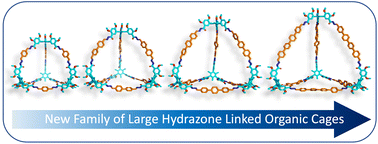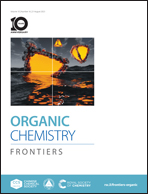Efficient multigram procedure for the synthesis of large hydrazone-linked molecular cages†
Abstract
Covalently linked molecular cages can provide significant advantages (including, but not limited to enhanced thermal and chemical stability) over metal-linked coordination cages. Yet, while large coordination cages can now be created routinely, it is still challenging to create chemically robust, covalently linked molecular cages with large internal cavities. This fundamental challenge has made it difficult, for example, to introduce endohedral functional groups into covalent cages to enhance their practical utility (e.g., for selective guest recognition or catalysis), since the cavities would have simply been filled up with such endohedral functional groups in most cases. Here we now report the synthesis of some of the largest known covalently linked molecular tetrahedra. Our new covalent cages all contain 12 peripheral functional groups, which keep them soluble. They are formed from a common vertex, which aligns the hydrazide functions required for the hydrazone linkages with atropisomerism. While we previously reported this vertex as a building block for the smallest member of our hydrazone-linked tetrahedra, our original synthesis was not feasible to be carried out on the larger scales required to successfully access the larger tetrahedra. To overcome this synthetic challenge, we now present an improved synthesis of our vertex, which only requires a single chromatographic step (compared to 3 chromatographic purification steps, which were needed for the initial synthesis). Our new synthetic route enabled us to create a whole family of molecular cages with increasing size (all linked with hydrolytically stable hydrazone bonds), with our largest covalent cage featuring p-quarterphenyl linkers and the ability to encapsulate a hypothetical sphere of approximately 3 nm in diameter. These results now open up the possibility to introduce functional groups required for selective recognition and catalysis into chemically robust covalent cages (without blocking the cavities of the covalent cages).

- This article is part of the themed collection: Organic Chemistry Frontiers Emerging Investigator Series 2022–2023


 Please wait while we load your content...
Please wait while we load your content...